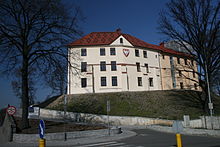- Duchy of Oświęcim
-
- The title of this article contains the following characters: ś & ę. Where they are unavailable or not desired, the name may be represented as Duchy of Oswiecim.
Duchy of Oświęcim
Księstwo Oświęcimskie (pl)
Herzogtum Auschwitz (de)Silesian duchy ← 
1315–1564  →
→Coat of arms of the Austrian Dukes of Auschwitz, 1890
Capital Oświęcim Government Principality Historical era Middle Ages - Partitioned from
Cieszyn1315 - Vassalized by
Bohemia1327 - Split off Zator 1445 - Sold to Poland 1457 - Incorporated into
Kraków Voivodeship1564 - Seized by Habsburg 1772 The Duchy of Oświęcim (Polish: Księstwo Oświęcimskie), or the Duchy of Auschwitz (German: Herzogtum Auschwitz), was one of many Duchies of Silesia, formed in the aftermath of the fragmentation of Poland.
It was established about 1315 on the Lesser Polish lands east of the Biała river held by the Silesian branch of the Polish royal Piast dynasty. Briefly semi-autonomus, with its capital in Oświęcim, it was finally sold to the Kingdom of Poland in 1457. Annexed by the Habsburg Empire in 1772, the remaining ducal title ceased to exist in 1918 with the lands being reincorporated into the Second Polish Republic.
Contents
History
The duchy was created in 1315 in the aftermath of the ongoing 12th century fragmentation of Poland on these southeastern estates of the original Duchy of Silesia, which the Polish High Duke Casimir II the Just had split off the Seniorate Province and granted to the Silesian duke Mieszko IV Tanglefoot in 1177. From 1281 onwards, the area had been part of the Silesian Duchy of Teschen (Cieszyn) until after the death of Duke Miezsko I in 1315, the lands of Oświęcim east of the Biała were split off from it as a separate duchy for Mieszko's son Władysław. In 1327 his heir Duke Jan I the Scholastic paid homage to King John of Bohemia and likewise many other Silesian duchies, Oświęcim became a vassal of the Bohemian Crown.
In 1445 the duchies of Zator and Toszek were created from some the lands of the duchy.[1] Though the Duchy of Oświęcim had fallen under the Bohemian vassalage, it was re-united with Poland in 1454, when the last duke, Jan IV, declared himself a vassal of the Polish king Casimir IV Jagiellon. Jan had no male heirs and sold his duchy to King Casimir for the price of 3,000,000 Prague groschen three years later.
At the General sejm of 1564, King Sigismund II Augustus issued privileges of incorporation recognizing both Duchies of Oświęcim and Zator as part of the Polish Crown into the Silesian County of the Kraków Voivodeship, although the Polish kings retained both ducal titles.
After the First Partition of Poland in 1772, the lands of the former duchies of Oświęcim and Zator were affiliated to the Habsburg Kingdom of Galicia and Lodomeria, an Austrian crown land from 1804, and joined the German Confederation in 1818. By the 1919 Treaty of Saint-Germain-en-Laye they were attached to the Polish Kraków Voivodeship.
Dukes of Oświęcim
The Dukes of Oświęcim belonged to the Silesian branch of the Piast dynasty (see also Dukes of Silesia).
1314/5-1321/4 Władysław I (son of Mieszko I of Cieszyn, from 1290 co-regent, due to division of Oświęcim) 1321/4-1372 Jan I the Scholastic (son of Władysław I) 1321/4-1325 Eufrozyna Mazowiecka (wife of Władysław I, mother of Jan I, regent, d. 1329) 1372-1375/6 Jan II (son Jan I) 1375/6-1405 Jan III (son of Jan II, died childless) 1405–1406 Przemysław (also known as Przemysław the Younger (Młodszy), son of Przemysław I Noszak (whose uncle was Mieszko cieszyński), from 1404 prince of half of Ścinawa and Głogów, from 1405 also in Toszek) 1410-1433/4 Casimir I (son of Przemysł Młodszy, due to division in 1414 of Oświęcim, Toszek and Strzelin (in Strzelin until 1427)) 1433/4-1484 Przemysław of Toszek (son of Casimir I, also prince of Toszek due to its division in 1445) 1433/4-1456 Jan IV (Janusz) (brother of Przemysław Toszecki and son of Kazimierz I, also prince of Toszek, from 1445 due to a division of Oświęcim, 1465-1482 Gliwice, abdicated (Oświęcim transferred to Crown of Poland), d. 1496) Rulers claiming the ducal title after partition of Poland
In the aftermath of the First Partition of Poland until 1918, the Habsburg Holy Roman Emperors, from 1804 Emperors of Austria held the title of a Duke of Auschwitz (German: Herzog zu Auschwitz) which constituted part of their official grand title.
Emperor Acceded Deceded Joseph II 1772 20 February 1790 Leopold II 20 February 1790 1 March 1792 Francis I 1 March 1792 2 March 1835 Ferdinand I 2 March 1835 2 December 1848 Francis Joseph I 2 December 1848 21 November 1916 Charles I 21 November 1916 11 November 1918 References
- ^ The History of the City of Oświęcim www.auschwitz.org.pl (based on "Auschwitz 1940-1945. Central Issues in the History of the Camp", published by the Auschwitz-Birkenau State Museum, Poland)
Duchies of Silesia 
Original 
Lower Silesia Upper Silesia Duchy of Bielsko · Duchy of Bytom · Duchy of Cieszyn · Duchy of Głubczyce · Duchy of Krnov · Duchy of Opava · Duchy of Opole · Duchy of Opole and Racibórz · Duchy of Oświęcim · Duchy of Pszczyna · Duchy of Racibórz · Duchy of Siewierz · Duchy of ZatorOther Categories:- Former principalities
- Former countries in Europe
- States and territories established in 1315
- States and territories disestablished in 1564
- Duchies of Silesia
- Historical regions in Poland
- Former duchies of the Kingdom of Bohemia
Wikimedia Foundation. 2010.


